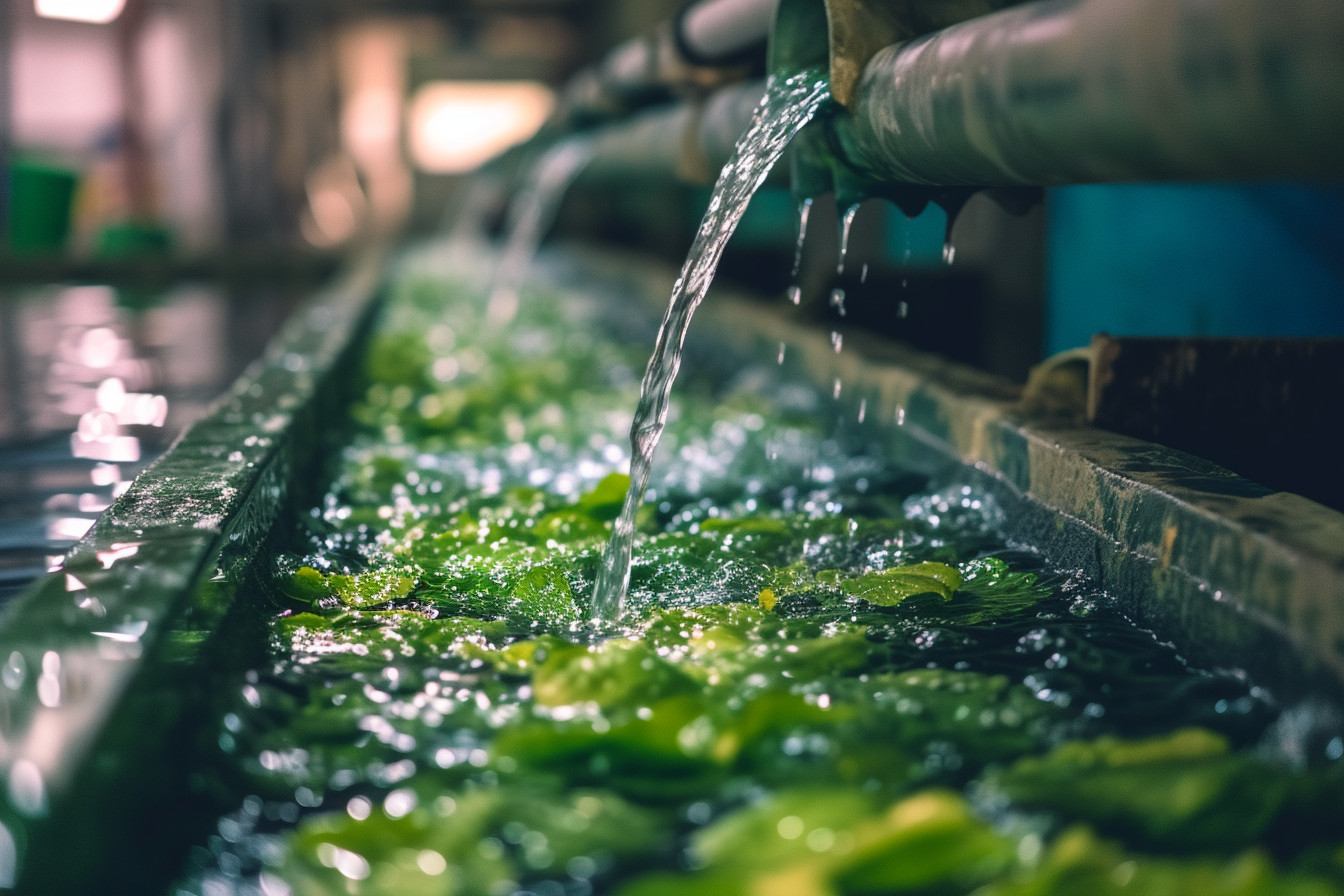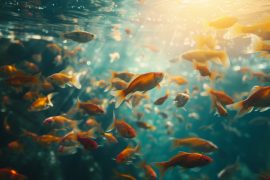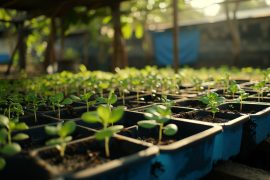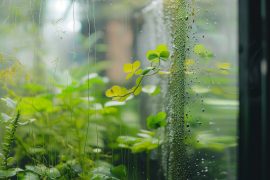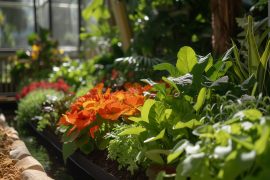Diving into the world of aquaponics has been one heck of an adventure for me. It’s like having this little ecosystem right in your backyard, where fish and plants live together in harmony. But if there’s anything I’ve learned along the way, it’s that keeping water clean is absolutely crucial to success. That brings us to biofiltration—a game-changer for anyone tinkering with aquaponics.
So what exactly is biofiltration? Well, imagine a bustling city inside your aquaponic system filled with microscopic cleaners whose sole job it is to tidy up after everyone else—those are your beneficial bacteria at work! They break down ammonia from fish waste into nitrates, which plant roots gobble up eagerly as nutrients, thus purifying the water without any chemicals needed.
Trust me when I say understanding and managing this natural cleaning crew makes all the difference between thriving greenery and aquatic life, or, well, let’s just not go there.
What is biofiltration?
Think of biofiltration as nature’s own recycling plant, especially when it comes to keeping the water in your aquaponics system crystal clear and perfectly balanced. It’s a bit like having an underwater garden that focuses solely on making sure everything else can thrive. At its core, biofiltration uses natural processes—think bacteria (the good kind!)—to break down unwanted materials in the water.
These tiny bacterial heroes convert fish waste products, which could otherwise harm fish and plants due to their toxicity levels, into less harmful substances like nitrates and nitrites. These byproducts are then used by plants as nutrients; hence, you get this beautiful cycle where each part supports another—true harmony between flora and fauna!
To give you a clearer picture,
- Fish produce waste.
- This includes the ammonia from respiration.
- Solid waste from uneaten food or feces
- Bacteria step up, breaking down these organics.
- Ammonia gets converted into nitrites first.
- Then other friendly microbes turn those nitrites into nitrates.
- Finally, plants absorb these nitrates through their roots as vital nourishment for growth.
Now imagine my little backyard setup—I call it “Aqua Oasis.” Each component plays its role beautifully! The trickling sound of water flowing through channels creates not just music but also circulates life itself around every touch point—cleansing and nurturing all at once.
Interestingly enough:
| Stage | Component Involved | Transformation |
|---|---|---|
| Initial Filtration | Mechanical filters | Removes solids |
| Bacterial Breakdown | Nitrifying bacteria | (NH4) + O2 → NO2 (NO2) + O₂ → NO₃ |
This table shows how systematic yet inherently simple Mother Nature’s process can be if we take time to understand her methods.
Starting with Aqua Oasis was initially daunting given my background wasn’t exactly science-heavy, but boy did curiosity pay off well! Delving deeper helped me uncover fascinating mechanics behind what seems to effortlessly maintain balance underwater, albeit hidden beneath serene surfaces conveying tranquil vibes only gardening spaces provide…
The Role of Biofiltration in Aquaponics
Diving into the world of aquaponics, we uncover a crucial component that keeps this ecosystem thriving: biofiltration. Imagine it as Mother Nature’s very own water purifier, but with a twist, where everything works in perfect harmony to create an environment where plants and fish coexist beautifully.
Biofilters are like backstage heroes in the aquaponics scene. They house beneficial bacteria vital for converting ammonia from fish waste into nitrates—plant food! This not only detoxifies the water, making it safe again for our finned friends, but also provides an organic nutrient source for growing vegetables or herbs—it’s sustainable living at its best.
Now you might wonder how all this magic happens. Well, think about tiny microscopic workers tirelessly processing waste 24/7—this is exactly what these good bacteria do. To give them proper credit and ensure they have ideal working conditions (temperature, pH level, and oxygen), maintaining your system becomes key, which isn’t too complicated once you get started!
Let me tell you, witnessing firsthand transformations within several setups fueled by biofilter technology has been nothing short of a love letter to earth itself. Their efficiency can be surprisingly impactful on overall health. Both aquatic and terrestrial life forms share the same space. Here’s a quick breakdown:
- Ammonia Conversion Rate: It highly depends upon factors such as temperature and species present; however, general consensus reports significant reductions in toxic levels under correct management.
- Plant Growth Enhancement: Noticeable improvements in size yield crops due to the constant supply of naturally derived nutrients directly attributable to diligent bacterial action
At the end of the day, stepping back and watching the complete cycle—from feeding time till harvest—the sense of fulfillment one receives knowing played a part in nurturing delicately balanced ecosystems brings indescribable peace. There’s just something truly mesmerizing about a circle that disregards conventional boundaries, showcasing instead that interconnectedness sustains us.
Components of a Biofiltration System
Diving into the heart of an aquaponics setup, you’ll find biofiltration isn’t just cool; it’s essential. Let me break down what goes into making this system tick. Imagine your garden underwater—yeah, that serene.
First up, we’ve got bio-media. It’s not as sci-fi as it sounds! These are surfaces like pebbles or plastic balls where bacteria can settle and grow. Without getting too geeky on you’, these bacteria are the unsung heroes converting fish waste (I know… ew) into plant-friendly nutrients through a process known as nitrification.
Then there’s something called a settling tank, which might sound fancy, but think of it more like nature’s pause button—it lets all the solid stuff from the water sink to the bottom before hitting our main event: the plants themselves get their fill without dealing with any gunk competing for attention.
But wait, every hero needs backup, right? Enter stage left:ammonia-removing media found in some systems really ups its game by extra-filtering harmful ammonia directly out of water, giving both creepy crawlies below and greens above better living conditions.
And don’t forget the pump—I mean, how else is all this clean water supposed to circulate back to start its journey anew? Quietly ensuring everything stays connected yet subtly reminding us about cycles within gardening itself—growth renewal—in comeback after each season ends only begin again stronger next round.
Understanding Different Types of Biofilter Media
Diving into the world of aquaponics, it’s clear that keeping your water clean isn’t just a priority; it’s essential. And when we chat about purifying that H2O, biofiltration media is the unsung hero in this story. So grab your gardening gloves and let me take you through the magical forest of biofilter media types.
First things first, mechanical filters catch those bits you’d rather not have floating around, like leftover fish food or plant debris. Think sponges or foam pads—simple yet effective at trapping particles before they become an issue.
Then there are biological mediums—it’s where science feels more like art than ever! Lava rocks, ceramic rings—you name it—all play host to beneficial bacteria munching away on harmful ammonia and nitrites, transforming them into less toxic nitrates that plants can absorb as nutrients—a perfect instance of nature looking after herself if I’ve ever seen one!
Let’s not forget about our friend: moving bed filter medium brings us closer to watching a ballet underwater—as dynamic as its name suggests! These plastic bioballs move freely within their chamber, powered by air pumps, allowing for the maximum oxygen exposure necessary for bacterial colonization.
The answer lies in constant motion here, folks, delivering efficient filtration 24/7 without breaking a sweat—or would they even?
Biochar has been making waves recently too, thanks to its sustainability points skyrocketing off-the-charts, doubling up both as superb biological filtering material and reducing waste significantly, because, guess what?
It joins forces with peat, moss, corn cobs, etc., forming multiple layers inside static chambers, ensuring every drop passing through emerges cleaner, lighter, and rejuvenated, ready for a continued journey throughout the aquaponic garden, lending touch magic, cycling moments, and eternity.
So yeah, venturing deep into different kinds of materials used across various contexts truly does wonders. Understanding the intricacies involved in maintaining pristine conditions underlies a successful system that thrives beyond expectations.
Let these moments reflect upon the natural processes that enabled tailored arsenals of inspiring approaches. Religiously adopted gardens worldwide turn shots dark, empowered, educated guesses Navigating uncertain terrain becomes a breeze.
The Benefits of Biofiltration in Aquaponics
So let’s dive right into the heart of biofiltration and why it’s a game-changer for aquaponic gardeners. Imagine having a system that not only sustains your plants but also cleans itself, reducing waste and keeping both fish and plants healthy. That’s what biofiltration offers.
First off, biofilters kick toxins to the curb without needing harsh chemicals or frequent water changes. They convert ammonia from fish waste—pretty toxic stuff—into nitrates, which plant roots gobble up happily as nutrients. This natural process means you’re less reliant on synthetic fertilizers since a lot of what your green buddies need comes straight from this eco-friendly cycle.
For those who cringe at the thought of murky waters ruining their pristine setup, fear not! Balanced, crystal-clear water is another thumb-up thanks to these biological workhorses helping remove debris before they turn visual joy into an eyesore.
Here are some cool stats I stumbled upon:
- Systems with effective biofiltration can reduce nitrogen levels by up to 50%.
- Water clarity improvement has been observed within just 72 hours after incorporating well-functioning biofilters!
And here’s where it gets personal: my buddy once had this gorgeous tomato vineyard going through rough times due to unbalanced chemical use—an all-too-familiar tale among us growers—took him ages plus loads more cash than planned, trying every treatment possible until he decided on integrating an efficient bioblock filter… Long story short? His tomatoes are now thriving beyond belief because the stable conditions underpinning his little ecosystem were restored starting that very season!
Lush growth thrives when you match efficiency with nature‘s own purification method, resulting in:
1. Those validation moments of seeing flourishing life forms rely solely on each other.
2. Knowing deep down how sustainability isn’t just a buzzword—it manifests vividly across our setups. Maintaining balance and minimizing outside interference wherever we possibly can help keep the peace between human involvement and planetary wellness. Too bad it ain’t always easy, though, huh?
Maintaining a Biofiltration System
Maintaining a biofiltration system in an aquaponics setup isn’t just about keeping the water clean; it’s akin to tending to a garden that flourishes under your care. It connects you with the cycle of life, right there in your backyard or even inside your home. Think of it as nurturing not only plants and fish but also millions of beneficial bacteria that play an indispensable role.
First things first, let’s talk consistency. Regular checks are vital—your system depends on balance.
- Monitor pH levels: Ideal is between 6 and 7 for most systems.
- Temperature check: Keep consistent; sudden changes stress both flora and fauna.
These might seem like basic steps, yet they’re crucial foundations for ensuring everything thrives harmoniously together.
Then there’s cleaning without disturbing this delicate ecosystem you’ve built up over time! This can be tricky if you’re new to this, because who would’ve thought filters needed gentle handling?
- Gently rinse mechanical filters using water from your own tank (not tap!) every few weeks.
It prevents harming those microscopic helpers doing all the hard work behind the scenes—a little thank-you wash, really!
You’ll find yourself becoming quite familiar—and dare I say fascinated?—with nitrification cycles without ever learning any such thing existed before venturing into aquaponics gardening. Nurturing these processes includes the following:
- Ensuring adequate ventilation and airflow around tanks
Crafting spaces where air meets water surfaces doesn’t require fancy equipment—an old-school fan will do!
Feeding schedules also deserve mention since they directly affect biological filtration efficiency.
Overfeeding = more waste = harder-working microbes
So stick to what’s recommended for your specific set-up and inhabitants.
Admittedly, during my initial plunge into the waters, so to speak, nothing calmed me more than knowing that, amidst achieving sustainable food sources, we were contributing positively towards our planet by mimicking natural ecosystems—inside four walls!
Incorporating methods passed down through generations while embracing innovations captures the essence of modern-day gardeners striving for a harmonious existence with nature rather than dominance over it.
That profound respect mirrors the dedication required to maintain biofilters. Each small step contributes to a greater collective effort to keep one another healthy and thriving.
Common Challenges in Biofiltration
Diving right into the world of aquaponics, it’s impossible not to marvel at how this system mimics nature’s very own process of purifying water. Yet, despite its innovative approach to sustainability and food production, biofiltration doesn’t come without its share of hiccups.
One major challenge is maintaining the balance among various microbial communities within the biofilter. It sounds pretty high-tech, but think about it like trying to host a dinner where you’ve got vegans, carnivores, and everyone in between; pleasing them all requires finesse! In our case here, with plants and fish depending on these microbes for clean water, finding that sweet spot can be quite tricky since changes in temperature or pH levels could tip the scales unfavorably.
Then there are those moments when you notice your system just isn’t filtering as effectively as before—an indication that clogging might be happening. This one relates more than we’d like because who hasn’t faced a blocked sink at least once? Over time, debris accumulates, especially if plant matter breaks down within your setup, potentially leading to reduced oxygen flow and unhappy aquatic life.
What compounds these challenges further is managing nitrogen cycles efficiently: certain bacteria convert ammonia excreted by fish waste first into nitrites, then nitrates, which plants absorb happily. However, balancing this delicate dance plays a crucial role in keeping both parties thriving; otherwise, hello toxic buildup, goodbye healthy environment!
Lastly, understanding diagnostic signs becomes essential to overcoming anything thrown your way, whether discolored leaves or slower growth rates. Understanding cues from living beings interacting on a daily basis offers insights for making informed decisions along the journey, yet it reduces the likelihood of running into serious issues.
Long-term sharing of stories, fellow enthusiasts, key learning, and growing together—after all, community-driven solutions yield the greatest impact, ensuring prosperous ecosystems every step of the way. Let me tell you, patience and resilience go hand in hand when navigating complexities in an astonishingly rewarding field. Aquaponic gardening is truly an art of science intertwined with manifestation.
I hope future generations connect, nourish bodies, and sustain the planet simultaneously. What magnificent blend of technology meets tradition wouldn’t agree?
Tips for Maximizing Biofiltration Efficiency
Ensuring that the water in an aquaponics system remains clean and balanced is more art than science. It’s about creating harmony between your aquatic inhabitants and their plant partners above the surface. Let me share a few tricks I’ve picked up over time to keep this balance without breaking a sweat or, worse, losing any of our dear friends.
First things first: Optimize your system design from day one. The shape and size of your biofilter matter way more than you’d initially think! Aim for designs promoting maximum contact time between water, beneficial bacteria, and plants—a longer interaction means better nutrient breakdown efficiency—and watch as nature takes care of most of the heavy lifting for you.
- Use media beds filled with light expanded clay aggregates (LECA) or gravel; these provide ample surfaces on which those good little bacterial warriors can grow.
- Ensure adequate flow rates; too slow might lead not only to insufficient filtration but also to anaerobic pockets harmful to both fishy folk and underwater plant pals alike!
Final Thought
So there you have it. We’ve journeyed together through the intricate world of biofiltration in aquaponics, discovering its vital role in keeping water crystal clear and fish happy. Let’s take a moment to breathe in that sense of accomplishment—it feels good, doesn’t it? Reflecting on this exploration brings about an appreciation for not just the scientific ingenuity behind these systems but also their harmony with nature.
Delving into biofilters wasn’t just a dive into technical specs or biological processes; it was more like getting to know a silent guardian of our aquatic friends’ homes. These unsung heroes work tirelessly day and night, ensuring that harmful ammonia levels are kept at bay while providing essential nutrients for plant buddies thriving above.
And here’s something cool I discovered: balancing your system might seem daunting at first glance, but understanding those basics really does go a long way! It turns out managing pH levels and monitoring nitrogen cycles isn’t as complex when broken down step-by-step—pretty nifty if you ask me!
Yet another takeaway from this adventure is how sustainable practices can be integrated right into our backyard projects (or fancy schmancy setups if you’re all-in). The beauty lies in its simplicity yet profound impact:
- Water conservation: Reusing water slashes consumption drastically.
- Chemical-free produce: What grows is free from harsh chemicals—healthier for us and planet Earth!
Bringing everything full circle—I hope my venture has lit up some light bulbs over heads showing brilliant ways we could foster greener living spaces without leaving footprints larger than necessary.
